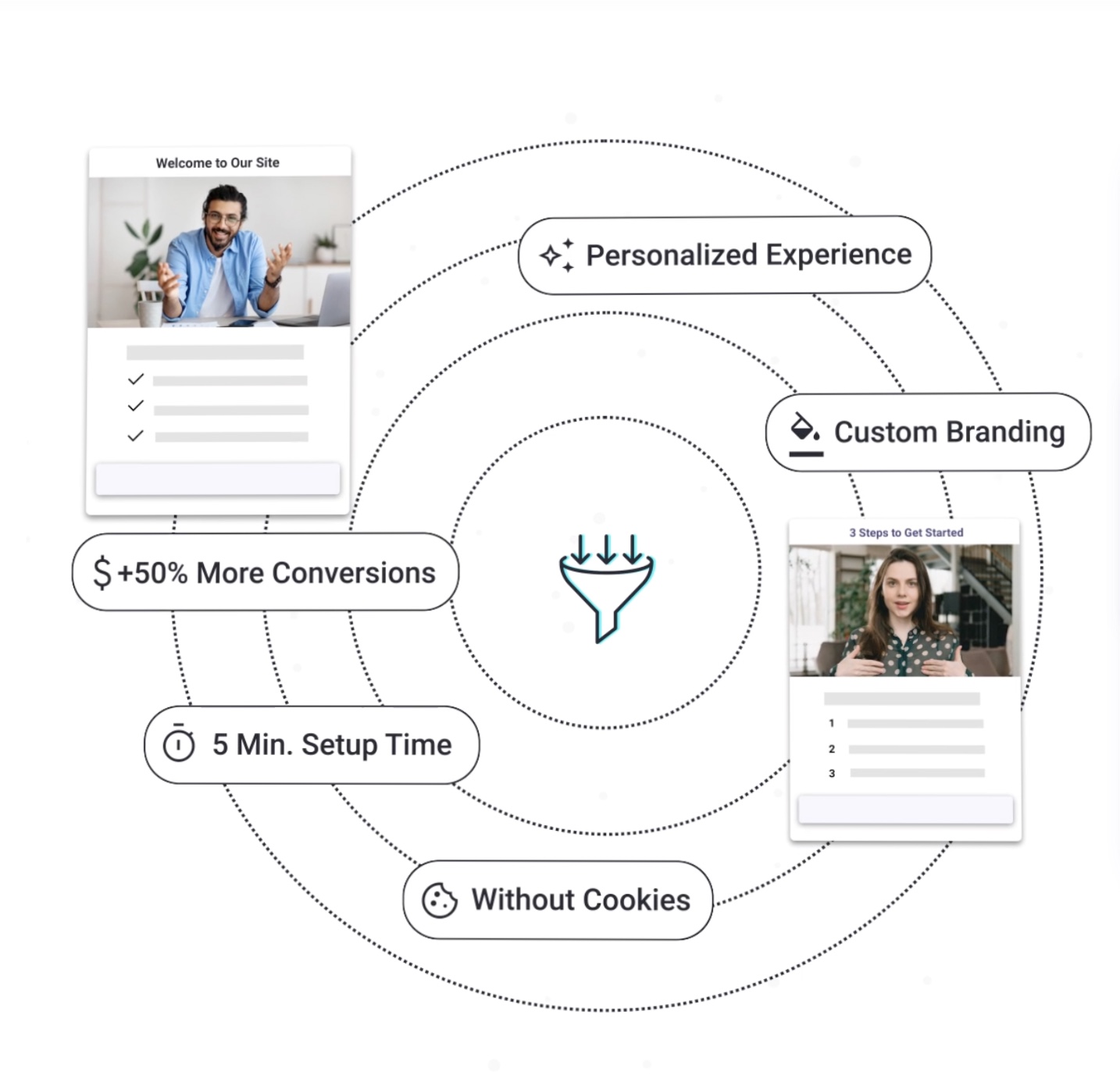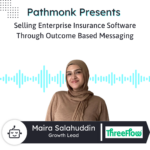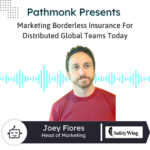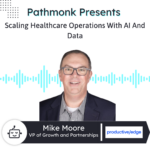
Introduction
In this insightful episode, we welcome Stephen Cuccio, Vice President of Growth at Movéo, a growth-based agency with 36 years of experience.
Stephen shares Movéo’s expertise in B2B marketing, focusing on their comprehensive approach to the total marketing lifecycle. He discusses their strategies for lead generation, customer retention, and sales activation across various industries.
Listeners will gain a deep understanding of how Movéo helps clients complete their entire marketing journey, from prospect marketing to customer engagement and beyond.
More Sales From Your Website With AI
Personalized interactions based on your users' behaviour to get +50% more conversions.

Ernesto Quezada: Pathmonk is the intelligent tool for website lead generation. With increasing online competition, over 98% of website visitors don’t convert. The ability to successfully show your value proposition and support visitors in their buying journey separates you from the competition online. Pathmonk qualifies and converts leads on your website by figuring out where they are in the buying journey and influencing them in key decision moments. With relevant micro experiences like case studies, intro videos, and much more, stay relevant to your visitors and increase conversions by 50%. Add Pathmonk Presents to your website in seconds. Let the AI do all the work and get access to 50% more qualified leads while you keep doing marketing and sales as usual. Check us out on pathmonk.com. Welcome to today’s episode. Let’s talk about today’s guest. We have Stephen from Moveo, vice president of growth there with them. How are you doing today, Stephen?
Stephen Cuccio: I’m good, Ernesto. Thanks for having me.
Ernesto: It’s great to have you on. And, well, I mean, a lot of trajectory there with Moveo—30 years plus in the making—so give us a little bit of a rundown. In your own words, tell us what Moveo is all about.
Stephen: Yeah, so we’ve been around a long time. Certainly had a ton of success. I think this is year 36 for us. But we started as a small Chicago-based agency and have really grown into a growth-based agency that focuses on specific industries that we do really well in. We’ve done a ton of work in the healthcare space—think healthcare organizations, hospital systems, providers, all that kind of stuff. We’ve worked with a number of different folks that are looking to generate new patient volumes and retain existing patients, working with strategy and research and all that kind of stuff. We then jumped into what I would call the B2B healthcare space—so a lot of med tech folks, a lot of pharmaceutical manufacturing, that kind of stuff—and then naturally continued to spin into the B2B verticals like industrial manufacturing, technology, energy, all that good stuff. Really, what we focus on is the total marketing lifecycle—so not only lead generation, but thinking about how you are retaining and growing those existing customers, how your sales teams are being activated, are you continuing to experiment, are you continuing to create a content strategy? It’s really the culmination of full strategy and execution that allows you to continue to grow. And that’s kind of what we’re all about—partnering with clients and making sure that they’re set up from A to Z and continuing on that growth trajectory.
Ernesto: That’s important. Awesome to hear that. And so that way our listeners who are tuned in, Stephen, can get a good understanding of Moveo. What would you say is that key problem that you guys like to solve for clients?
Stephen: Yeah, so it’s really around the fact that most folks don’t identify that there’s a full marketing pie that you need to go after. You get a lot of folks that are a little bit more tunnel-visioned in the sense that, “Hey, paid media placement is going to be the one-all-be-all for our success,” or, “I really need to focus on SEO,” or, “I’m really just working on branding and I know if I relaunch this campaign, it’s going to be in a good spot.” Where we kind of come into play is identifying what we’re calling growth drivers, which are your traditional prospect marketing—so account-based marketing, ABM, lead generation, awareness, branding, that kind of stuff—forming that into customer marketing, so like customer journey mapping, UX/UI, all that good stuff, continuing to funnel them through content marketing—so content strategy placement, creation of that content, all that good stuff—and then moving them into sales activation. So really, if you’re thinking of it from a cyclical standpoint, it’s a full circle. And I mentioned that pie before, but where we come in is to help on the strategy and execution of completing that entire circle so you don’t have any gaps where people are falling through.
Ernesto: Definitely important. And so, I mean, we did mention one of the sectors that you guys like to go for is healthcare and then industrial manufacturing. Would those be your ideal ICPs, or are there other vertical segments that you guys also like to go for as well?
Stephen: Yeah, I mean, we’ve identified those as pretty much our ICPs because of the experience and the knowledge sharing that’s involved there. They’re pretty complex industries on totally different spectrums, but they do have some similarities. A lot of the healthcare stuff is like a different language to some folks, so identifying that and being able to navigate it has been helpful for our clients. Same thing on the industrial manufacturing, big tech, energy side of the business. But we really, really focus on B2B growth marketing outside of the healthcare space. If you’re looking for lead generation, prospect generation, sales activation, kind of all of the above, we’re able to do a good job of generating what we like to call mid- to bottom-funnel leads for our B2B clients.
Ernesto: Okay, perfect. Great to hear that. And so say I am in the healthcare industry or industrial manufacturing, how would I usually find out about Moveo? Is there a top client acquisition channel for you guys?
Stephen: Yeah, so our website is actually going through a rebranding, so it’s kind of perfect timing to have this conversation. It’s movaio.com. We have a ton of thought leadership content, a ton of white papers. We’re actually putting up some webinars and all that good stuff up there. And then you can follow us on LinkedIn, Instagram, kind of all the traditional social media stuff. Same thing, Movaio is the handle there. I think Instagram is moveo_chicago because somebody else snapped up movaio at some point in the past. But yeah, we’re pumping out some good content and always looking for feedback. If there’s stuff that you see in the industry that we’re not mentioning, we’d love to dive in and do some research based on some of the folks that are producing the content on our end and see if there’s some similarity or some stuff that we can investigate and uncover a little bit more.
Ernesto: All right, perfect. Awesome. You did mention the website, which is movao.com. What role does the website play for client acquisition?
Stephen: Yeah, so for us, the website is a big part of it because of all the thought leadership and content that we have on there. We actually recently started to look at some of the evaluation aspects of bounce rates and jumping off the website at a deeper level. Right? We had some of those high-level Google Analytics stats, but to be able to match that up with some of our contact database has been super helpful as we’re pumping out that content. And I think a big part of it from a marketing standpoint, when you’re looking at the MQLs versus the SQLs, you get a lot of folks specifically in the B2B space where those departments rub up against each other. Marketing has generated a ton of leads, but sales aren’t able to close them or vice versa. What we’ve identified is if you’re able to track these customer journeys as you’re continuing to educate, you’re going to identify through lead scoring who’s going to be the most effective to reach out to, which then helps the sales team be more efficient, close more deals, and everybody’s happier. A big part of that is tracking that conversion on the website, not only from a form fill or an actual lead submission, but from engagement on a white paper, engagement on a blog. Are they looking at our strategies? Are they downloading different stuff on the website? And then backing that up to some of our email outreach, using that as retargeting across the platform. So really, to us, the website is the house. It’s the foundation of what we’re doing, and then everything else kind of shoots off that.
Ernesto: Okay, perfect. Awesome. On that note, Stephen, is there any tools or tips or methods that you would recommend to our listeners as far as some website lead generation?
Stephen: Yeah, so I think on the website itself, people tend to lose sight of the actual customer journey, especially as you’re looking to ramp up your website in a rebrand or if you’re launching a startup. You get really excited about dumping all the information in there—”Hey, I want them to know about this strategy or this, or how we’re doing this or a case study,” and, like, it becomes a little bit overwhelming. So what I always encourage folks to do is to take a step back and understand, if I was coming to Ernesto’s company, right, outside of Pathmonk—let’s say you had an agency—if I’m coming to you to look for different services, how would I want that experience to look? What am I looking for in an engagement standpoint? And typically, the value is thought leadership, case studies, strategy, lead generation. So it’s a lot about, “Hey, what am I thinking about? How am I thinking of it? What’s happening in the industry? Does he understand what I’m doing and why I’m trying to do it?” Then it’s, “Has he done it in the past? Has he helped competitors? What can he translate from his previous work to help me out?” Then it turns into, “Well, does he even offer the services that I’m looking for?” And then it turns into the actual lead generation. So you kind of follow that Pathmonk and understand the user journey. And it certainly varies, but that’s kind of the benefit of looking at different heat mapping mechanisms and understanding clicks and engagement. But typically, if you follow that Pathmonk, it leads to more leads.
Ernesto: Definitely important insights there. Well, let’s switch gears a little bit then, Stephen, and let’s talk about you as a leader—you being the VP of growth there for Movaio. What are some key tasks you focus on in your day-to-day work?
Stephen: Yeah, so really what I lead over here is kind of the entire sales and marketing motion. A big part of that is setting up myself for success first thing in the morning. So I have kind of a cadence that I roll through. Typically it’s, you know, your daily check-in to your emails. Then I really bounce into our HubSpot CRM, I bounce into our website tracker, I bounce into our database and map all of that up via the dashboard that we leverage to identify who’s engaging on the site, who engaged with this content. Did we generate any leads overnight? Should we identify a strategy based on some of the intent models that we’re seeing out there? So it’s a cadence of about four or five things, but out of those four or five things, I’m able to put together a short punch list of, “Hey, I identified that this hospital system in Kansas was engaging with our website. We have an employee that used to work with them at a previous company and we have a full email list and new content that I can pump out to them. Let me prioritize that and get a note out to them or pick up the phone and give them a ring and see if we can strike up a conversation.” So that kind of early checklist allows me to set up the rest of my day for success.
Ernesto: Definitely important. Okay, awesome. And in the between time that you do get available, Stephen—because it sounds like you have a full plate there on your hands—how do you stay up to date with all the marketing news, trends, and strategies out there? Is there a preferred channel that you like to go with?
Stephen: Yeah, I subscribe to a ton of email newsletters, listen to as many webinars and podcasts as possible. We don’t necessarily have one that maybe stands out on the webinar or podcast standpoint, but I would say from a newsletter standpoint, Search Engine Land puts out great content. Moz puts out great organic content. HubSpot has one that you can subscribe to that’s pretty good. And then on the new emerging front, the Marketing AI Institute, which is a guy that had an agency, sold his agency because he saw the growth of AI and actually pivoted his entire strategy to identifying what’s happening in AI, how to navigate it as a marketer and an agency. He puts out a ton of great content. He and his team do a great job of putting on webinars and engagements. They have free content, they have gated content. They actually have a conference in September or October or something like that. That’s really good content information as well. But it really walks you through the emerging aspect of AI, how to leverage it, how to eliminate that negative stigma of all of the stuff that’s happening with it. So that’s been one of the newer channels that I’ve been looking into, and it’s been super helpful.
Ernesto: Definitely. All right, thank you so much for those tips there for our listeners. They’re always good, right? Like you mentioned, that’s a great pivot and it’s working, right? So awesome.
Stephen: Yeah.
Ernesto: All right, well, let’s jump into our next section then here, Stephen, which is the rapid-fire question round. Are you ready for them?
Stephen: Yeah, let’s do it.
Ernesto: Awesome. First off then, Stephen, what is the last book that you read?
Stephen: The last book that I read actually was a birthing partner’s book. My wife gave birth to my daughter. She’s about eight months old, so I’ve been kind of doing that—some parenting books and stuff like that. Not really revelant for this conversation, but that’s the last one I picked up, start to finish.
Ernesto: No, but that’s great, right? I mean, putting in the time to work, reading the books because it’s tough with a newborn and the reactions and everything. So it’s a great read there from you. Next up then is if there would be no boundaries in technology, what would be that one thing that you want to have fixed for your role as a marketer today?
Stephen: That’s a great question. I would say continuing to layer tech stack onto website optimization is probably our biggest aspect. So a little bit more layered in that answer. I would want a full dedicated team to be leveraging the UI/UX and identifying visitors’ use cases there. Right now we’re piecemealing it together just based on budgets. But really what I would want to do is take my engineering team, replicate them, and then put them full-time on movaio.com to really beef up that lead generation aspect of the content we’re putting out.
Ernesto: Definitely important. Great to hear that. Next then is if there’s one repetitive task that you could automate, what would that be?
Stephen: Oh man, I don’t know if I can boil it down to one. I would say the contact scoring aspect of things. So like looking through the data, identifying the data, matching it up between our CRM and our data source and mapping that back and forth to then trigger the aspect of, “Hey, I need to reach out to them.” I think it would be super helpful if there was some sort of automated feature, and there is to a certain extent, but I would want it to go a little bit deeper in the sense of like, “Somebody clicked on the email, they also engaged with the website, it sends this automatic email. If they engage with the email, then it goes directly to my inbox and says, ‘Pick up the phone and call this person.'” And right now it’s a little bit more, the journey is there, but our tech stack isn’t set up correctly. So I think the repetitive nature of checking three different software applications and then identifying what makes the most sense could be eliminated with some sort of automation there.
Ernesto: Perfect. Awesome. Great. Thank you, Stephen, for sharing that. And, well, lastly, I mean, you have a lot of experience already in sales and then moved on to the marketing world. But what would be that one piece of advice that you would give yourself if you were to restart your journey as a marketer today?
Stephen: Yeah, I would say really identify the industry you’re going after and become a subject matter expert as quickly as possible and continue to be a subject matter expert as things could continue to pivot. So I’ll use healthcare as an example. Healthcare is a massive emerging industry, and it’s been that way for a long time. But there are some challenges that we’re facing coming out of the pandemic, moving into more of these kind of self-pay mechanisms and stuff like that. The rapid change associated there—you need to stay on the forefront of that as well as identifying if your industry is on the leading or the lagging spectrum of new technology. For example, healthcare itself is really a little bit behind when it comes to something like AI because of the compliance aspect around that. Same thing with more of the large industrial-sized aspects. Now, if you’re looking in the startup space, they’re willing to jump into AI because they’re looking for something that’s going to lead them to rapid growth. So identifying that and continuing to educate yourself on what makes the most sense in that industry would allow you to expedite the ability to get in front of folks with great content and be a tremendous marketer.
Ernesto: Awesome. Some great advice, not just for yourself, but for our listeners. Thanks so much for sharing that, Stephen. And well, we are coming to the end of today’s show, Stephen. But before we do end, I do want to give you the last word. If someone forgets everything about the interview today, what is that one thing they should remember about Moveo?
Stephen: One thing about Moveo, if you totally blacked out during this conversation, would be we’re experts in growth. So if you’re looking to grow, if you’re looking to complete your entire marketing journey lifecycle on top of sales—really revenue lifecycle—that’s what we do best. We’re able to generate leads, grow those existing customers, and then convert those leads on the sales end.
Ernesto: Exactly right. If our listeners are in healthcare, B2B, and you want to attract, secure, and retain more customers, check them out at moveo.com, where they focus on three drivers of growth—branding, lead generation, and customer engagement. Stephen, thank you so much for being on today’s episode with us. To our listeners, thanks so much for tuning in, and I’m looking forward to our next episode at Pathmonk Presents. Thanks a lot, Stephen.
Stephen: Yeah, thanks, Ernesto. This was great. I really appreciate it.
Ernesto: Appreciate you. Thank you.











